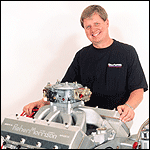|
|
|
#1 |
|
Senior Member
Join Date: Jun 2008
Location: nhranumbers.com
Posts: 869
Likes: 129
Liked 151 Times in 48 Posts
|
What kind of harmonics damage have any of you seen when using a 2 STEP?
|
|
|

|
|
|
#2 |
|
Senior Member
Join Date: Oct 2002
Location: Pittsburgh
Posts: 521
Likes: 246
Liked 550 Times in 106 Posts
|
Ive seen nothing so far. OEM cast crank, 2,600 to 3,200 on two step depending on rollout/ light conditions, and a good ATI damper. Also I don't mash the pedal once staged, I wait until the first yellow. So very little time is ever spent on the two step.
|
|
|

|
|
|
#3 |
|
Member
Join Date: Mar 2007
Posts: 346
Likes: 19
Liked 20 Times in 15 Posts
|
Look for an article in ND by Dave Reher. He answers it all.
|
|
|

|
|
|
#4 |
|
Member
Join Date: Jun 2002
Posts: 175
Likes: 0
Liked 0 Times in 0 Posts
|
Broke a camshaft bolt that looked like a harmonics failure. Installed a fluid damper never had any problems after. Lots of good info around about crankshaft harmonics and the role of a damper.
__________________
67 Ford Fairlane F/SA 749 |
|
|

|
|
|
#5 |
|
Junior Member
Join Date: Feb 2013
Location: cleveland ,ohio
Posts: 40
Likes: 1
Liked 0 Times in 0 Posts
|
Tech Talk #79 Ė Are Burnouts Abusing Your Engine?
 By David Reher, Reher-Morrison Racing Engines By David Reher, Reher-Morrison Racing EnginesI donít recommend using a stepped rpm limiter during the burnout. Itís all right to have a high-speed limiter as a backup to prevent over-revving the engine in case of a broken drivetrain or a stuck throttle. Itís not OK to put the throttle pedal on the floor and run the engine against the limiter for the duration of the burnout. Limiters work by cutting spark to the cylinders, essentially causing continuous misfires. Many are so effective that they can control the engine speed to within a few rpm. The downside, however, is that the prolonged interruption of the cylinder firing is very hard on an engine. Instead of a steady flow of power pulses being delivered to the crankshaft, the power comes in starts and stops as cylinders are dropped and fired again. The intense vibrations that result are transmitted throughout the engine, affecting the crankshaft, the camshaft drive, and the valvetrain. The driver canít appreciate whatís happening because the engine is usually popping, banging, and running rough when itís on the limiter Operating an engine at a specific rpm imposed by an rpm limiter for an extended time during a burnout can have serious consequences if the natural frequencies of the components are in sync at that particular engine speed. Iíve learned this from my own experiences. Years ago, my late partner, Buddy Morrison, built a spin fixture to test valvetrain dynamics. It wasnít nearly as sophisticated as todayís Spintrons, but it did the job. We had a 460ci Ford hooked up to the test engine through a gear drive and spun the crankshaft at whatever rpm we wanted. Weíd watch what the valvetrain was doing at various rpm with a 60-cycle strobe light Ė and sometimes what we saw was shocking! At certain speeds, the valvetrain would be totally out of control, with the pushrods smoking and the valve springs bouncing completely off the heads and retainers. The particular rpm where these frequencies converged depended on many variables Ė the pushrod diameter and wall thickness, the valve spring pressure, the camshaft profile, the valve weight, the rocker arm ratio, and many other factors. It was an eye-opening demonstration of the effects of harmonics in a racing engine. Years later, I was reminded of that experience when Bruce Allen and I were breaking in tires with our Pro Stock on the day after a national event. Weíd left our race engine in the car, thinking that a few low-rpm burnouts to scuff new sets of slicks couldnít possibly damage it. Well, we just about killed that engine in the span of a few seconds. When I pulled off the rocker covers after the burnouts, there was smoke rolling out of the valley. The valve springs had collapsed, the pushrods were trashed, and we were fortunate we hadnít destroyed out best engine. Even though the engine was running far below its peak rpm, the particular engine speed that it ran during the tire break-in burnouts produced a perfect storm of valvetrain harmonics. A racing engine that operates across a range of speeds typically doesnít spend enough time at a specific rpm point to experience damaging harmonic vibrations. If the engine is electronically held at a prescribed rpm that excites harmonic vibrations by a rev limiter during a burnout, then the result can be internal damage. This damage is cumulative, with the parts deteriorating every time a burnout is done at the same rpm. When we disassemble an engine and find broken valve springs, damaged pushrod and rocker arm cups, and other signs of harmonic-related distress, it points a finger at the burnout procedure. An identical engine thatís run without a burnout rev limiter may show none of these symptoms because the driverís right foot canít hold the rpm at a constant prescribed speed. The problem is that the engine speed where harmonics occur canít be pinpointed Ė it depends on the complex interaction of all of the components. Change the pushrod diameter or install a set of beehive valve springs, and the valvetrain dynamics will change as well. In my experience, most of the engines that are in good condition when they come back for overhaul have been raced by drivers who do smooth burnouts Ė controlled by the throttle pedal, not by a limiter Ė and get off the gas before the tires grab. If a racer perfects this technique, the engine will live longer and perform better.
__________________
Steve Tucholsky |
|
|

|
|
|
#6 |
|
VIP Member
Join Date: Feb 2006
Location: Dela-where?
Posts: 2,116
Likes: 1,004
Liked 1,649 Times in 521 Posts
|
^^^^^thanks for that post. some good to know info
__________________
KEITH MAYERS 2 X somebody many X nobody |
|
|

|
|
|
#7 |
|
Senior Member
Join Date: Oct 2002
Location: Pittsburgh
Posts: 521
Likes: 246
Liked 550 Times in 106 Posts
|
Couldn't agree more. I want to scream when I hear burnouts on a two step. It's like nails on a blackboard. And totally unnecessary. If you can't modulate engine rpm in a burnout, you need to learn how, or find a new hobby/sport.
|
|
|

|
|
|
#8 |
|
VIP Member
Join Date: May 2006
Location: Louisville , KY
Posts: 1,994
Likes: 63
Liked 270 Times in 68 Posts
|
That backs up what I've thought for years. No two steps in our cars.
__________________
Greg Hill 4171 STK |
|
|

|
|
|
#9 |
|
Member
Join Date: Mar 2006
Location: EL PASO, TEXAS
Posts: 156
Likes: 0
Liked 2 Times in 2 Posts
|
Would this apply if you were using a msd :soft touch??? Just curious.
|
|
|

|
|
|
#10 |
|
Live Reporter
Join Date: Sep 2005
Location: Golden Beach Maryland
Posts: 1,232
Likes: 52
Liked 262 Times in 124 Posts
|
We've run in to this at the shop I work at. We've got a customer with a 555 BBC he came to us after breaking a timing chain. We repaired the damage (bent valves ect) replaced the chain and all was good for about 30 pass's and you guessed it, even with a up grade timing chain it broke again. He run's a burnout chip at a pretty high RPM The shop owner's been telling him to get rid of the chip maybe he'll believe David.
|
|
|

|
 |
«
Previous Thread
|
Next Thread
»
|
|
All times are GMT -4. The time now is 01:17 PM.































 Linear Mode
Linear Mode

